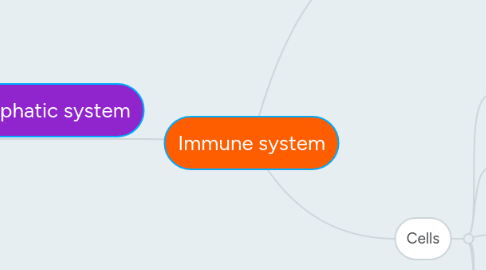
1. Lymphatic system
1.1. The lymphatic system maintains fluid balance in tissues, absorbs fats from the small intestine, and defends against microorganisms and foreign substances.
1.2. Organs
1.2.1. Thymus
1.2.1.1. The thymus is located in the thoracic cavity, just under the neck. It’s made up of two lobes of lymphoid tissue. Each lobe has a medulla surrounded by a cortex. The cortex is where immature lymphocytes first go to become T cells, but their maturation finishes in the medulla.
1.2.2. Spleen
1.2.2.1. The spleen is located in the upper-left part of the abdomen.The spleen’s main function is to filter the blood. It removes old or damaged red blood cells, which are phagocytized by macrophages.
1.2.3. Tonsils
1.2.3.1. The tonsils are masses of lymphoid tissue found in the back of the throat and nasal cavity.They’re part of the immune system, so they help fight infections, but removing the tonsils doesn’t appear to increase your risk of infections.
1.2.4. appendix
1.2.4.1. The appendix is a pouch of lymphatic tissue that’s attached to the large intestine.An obstructed appendiceal lumen can cause appendicitis when bacteria start to multiply.
1.2.5. Peyer’s patches
1.2.5.1. These patches of lymphoid tissue are located in the mucosa and submucosa throughout the small intestine, although they’re more concentrated in the ileum. Peyer’s patches contain mostly B cells.
1.2.6. Lamina propria lymphocytes
1.2.6.1. This type of GALT is located in the mucosa of the small intestine. It also contains mostly B cells.
1.2.7. Intraepithelial lymphocytes
1.2.7.1. These tissues are located between the cells of the epithelial layer of the small intestine, between the tight junctions.
1.3. cells
1.3.1. Chemotaxis
1.3.1.1. Is the ability of cells to move toward microorganisms or sites of tissue damage.
1.3.2. Neutrophils
1.3.2.1. Are the first phagocytic cells to respond to microorganisms.
1.3.3. Macrophages
1.3.3.1. Are large phagocytic cells that are active in the latter part of an infection. Macrophages are also positioned at sites of potential entry of microorganisms into tissues.
1.3.4. Basophils
1.3.4.1. Promote inflammation, whereas eosinophils inhibit inflammation.
2. Organs
2.1. Bone marrow
2.1.1. All cells are intially delivered
2.2. Thymus
2.2.1. to produce mature T cells.
2.3. Spleen
2.3.1. is an immunologic filter of the blood.It is made up of B cells, T cells, macrophages, dendritic cells, natural killer cells and red blood cells.
2.4. Lymph nodes
2.4.1. function as an immunologic filter for the bodily fluid known as lymph. Lymph nodes are found throughout the body.
3. Cells
3.1. T-cells
3.1.1. The main function of the T helper cell is to augment or potentiate immune responses by the secretion of specialized factors that activate other white blood cells to fight off infection.
3.2. Natural killer cells
3.2.1. They function as effector cells that directly kill certain tumors such as melanomas, lymphomas and viral-infected cells, most notably herpes and cytomegalovirus-infected cells.
3.3. B cell
3.3.1. The major function of B lymphocytes is the production of antibodies in response to foreign proteins of bacteria, viruses, and tumor cells.
3.4. Granulocytes or Polymorphonuclear (PMN) Leukocytes
3.4.1. Granulocytes are composed of three cell types identified as neutrophils, eosinophils and basophils, based on their staining characteristics with certain dyes
3.5. Macrophages
3.5.1. Macrophages are important in the regulation of immune responses.
3.6. Dendritic Cells
3.6.1. Dendritic cells, which also originate in the bone marrow, function as antigen presenting cells.
